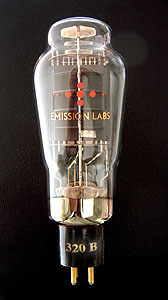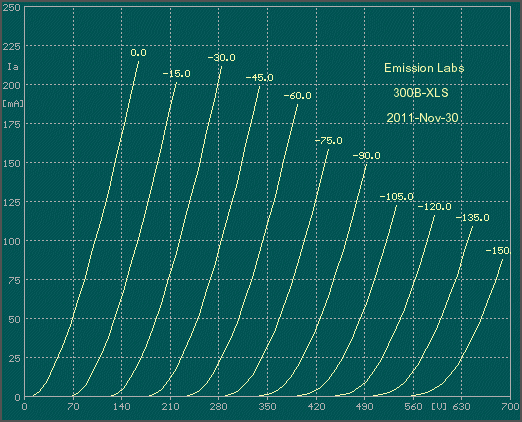EML 320B-XLS Data Sheet
Replaces also 842 tube
Description
 |
This tube is the same as 300B-XLS, apart from the heater current, which is higher. For this reason we point out only the differences, and for all other information we refer to the 300B-XLS data sheet.
|
The intention of 320B-XLS vs 300B-XLS
With tubes, when increasing the heater power, the tube gets more suited for harder conditions. For this reason we recommend the 320B in situations where 300B-XLS would be used near the end of it's possibilities. Such as biased close to maximum, and for Push-Pull amplifiers. Though Push Pull can be made with any 300B, it is known to be harder on the tubes than a Single Ended design.
Sound Character of the EML 320B-XLS
Generally the even higher heater power of the 320B-XLS will give the tube a fraction more impulsiveness if used at high output power. So for designers who want to get the upmost in terms of output power, but are reluctant to stress the 300B-XLS very hard, 320B-XLS is the choice.
For use in Push Pull amplifiers, this tube is also a natural choice, because this type of amplifier is hard on the tubes by definition. The 320B-XLS is made to deal with such conditions, and will allow the amplifier to play gently at low sound level, as well as reproduce higher sound level with the detail and precision you expect from a push pull amplifier.
EML 320B-XLS filament Ratings |
|
| Heater Voltage (AC or DC) | |
| Electronic heater modules: | Only voltage source |
| Tolerance on heater voltage | |
| heater Current | ~ 1.7 Ampere |
EML-320B-XLS Factory Test conditions |
|
| Anode Voltage | |
| Anode Current | |
EML-320B-XLS Factory Test Result at 495V, 110mA |
|
| Grid voltage ( DC heated) | |
| Transconductance | |
| Note: these are average values, variation is appr 5% for random tubes. Any other current will also give another transconductance | |
EML-320B-XLS incoming inspection. Tested at 495V, 110mAMultiply -Grid Voltage with transconduction |
|
| New tube | |
EML 320B-XLS Maximum Conditions
|
|
| Anode Voltage | |
| Anode Current | |
| Power Output in Class A | |
| Peak Anode Dissipation | 65 Watt, one minute |
Highest possible Grid to ground resistor, Single Ended. |
|
Highest possible Grid to ground resistor, Push-Pull. |
|
320B-XLS Recommended Single Ended operating points
| |||||||
Anode Voltage | Control Grid Voltage |
Anode Current (ma) |
Anode Rp (Ohm) |
Load (Ohm) |
Anode Dissi-pation (Watt) |
Power Output (Watt) |
2nd harm. (dB) |
| . | |||||||
450 |
-97 |
80 |
700 |
2000 |
36 |
18 |
22 |
450 |
-97 |
80 |
700 |
3000 |
36 |
15 |
26 |
450 |
-97 |
80 |
700 |
4500 |
36 |
12 |
31 |
| . | |||||||
475 |
-97 |
90 |
670 |
1900 |
43 |
21 |
23 |
475 |
-97 |
90 |
670 |
2800 |
43 |
17 |
27 |
475
|
-97 |
90 |
670 |
4200 |
43 |
14 |
32 |
. |
|||||||
500 |
-98 |
110 |
630 |
1800 |
55 |
27 |
23 |
500 |
-98 |
110 |
630 |
2700 |
55 |
22 |
27 |
500
|
-98 |
110 |
630 |
4000 |
55 |
17 |
32 |
Choice of output transformer impedance: For each working point, a wide range of primary impedance is possible. When using a transformer of another value, you can estimate the output power and distortion by averaging between two rows of this table. Example: 500V, 110mA. Use of Lundahl LL1623-120mA (3k type). This will give you appr. 20 Watt @ 28dB 2nd harmonics. (28dB distance of signal to 2nd harmonics. |
|||||||

Curves of 320B-XLS apply
Anode Curves Print Version (full size pdf)![]()
Download these curves as PTE file
Some recommended Lundahl transformers |
|||
| Primary |
Secondary |
Anode Current | |
| LL1623-090mA 11Hz @1.5dB |
3000Ω | Alt.B = 4Ω Alt.C = 8Ω Alt.D = 16Ω |
90mA |
| 3000Ω | Alt.B = 4Ω Alt.C = 8Ω Alt.D = 16Ω |
120mA | |
| Alternative: Use transformer Impedance Boards for LL1623 by JACMUSIC. EE16 switches between 4 and 8Ohms at 3k. EE18 switches between 8 and 16Ohms at 3k. |
|||
| 3000Ω | 8Ω | 80mA | |
Complete list of recommendations here |
|||
320B-XLS Mechanical Data
|
|
 Standard UX4 Base |
Pin 1: Heater1 |